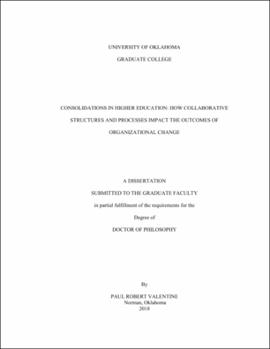| dc.description.abstract | Over the past several decades, institutions of higher education have found themselves in a difficult environment. States have reduced funding, total enrollment has either fallen or flattened across several years, and technological advancements have placed institutions in direct competition with a larger number of colleges and universities. In response to this changing environment, policymakers and administrators have increasingly looked at consolidation to reorient systems of higher education in a way that makes them more suited to participate in this environment.
These consolidations have wide-ranging impacts on administrators, faculty, staff, students, and communities by determining the missions, goals, procedures, and outcomes of colleges and universities. Additionally, these efforts are highly relevant to longstanding discussions in public administration on bureaucratic reform, bureaucratic structures, performance measurement, the role of efficiency, and accountability. Despite this, there has been little development in the literature on the outcomes of consolidations in the U.S.
This dissertation contributes to our understanding of these consolidations within two main components. The first component is an exploration of the outcomes of consolidations which occurred in the U.S. over the past two decades. Chapter 2 uses a propensity score matching method to compare consolidated institutions with a control group of highly similar, non-consolidated institutions. This analysis produced evidence that while consolidations may increase their revenue in the short term, those gains are offset by increased expenses and the failure to reduce costs in expected areas. Chapter 3 utilizes student-level data from the University System of Georgia which has, since 2012, consolidated several colleges and universities. Using this data, a gradient boosted decision tree regression model develops a prediction algorithm from retention patterns pre-consolidation to predict post-consolidation retention based on the characteristics of enrolled students. These predictions are then compared to observed first-year retention. This comparison provides some evidence that consolidating institutions experience an opportunity cost where students expected to retain instead depart from the institution, especially for the cohorts which enrolled immediately after consolidation implementation.
In the second component, qualitative interviews from consolidating institutions are used to explore how the process of organizational change is impacted by the collaboration between the consolidating institution. Based on the Institutional Analysis and Development (IAD) framework’s development of the external environment, particular the rules-in-use which define participants’ behaviors, Chapter 4 proposes a framework for understanding how the collaboration between institutions impacts organizational change. This process is based on two sets of factors. The first, persistent factors, are factors which relate to the process of change and collaboration and will therefore be present any time an organization is undergoing change or collaboration. These factors generally determine the time and resource costs to employees, with higher costs being related to more negative outcomes for employees and organizations. The second set, particular factors, are based on the IAD framework’s external environment, where rules-in-place change the behavior of participants, and thus either promote or constrain certain decisions within the organizational change based on the specific external environment of the participating institutions. | en_US |
